FIGHT TO MAKE ABORTION LEGAL, SAFE, AND FREE
Spike Kahn had been fundraising for abortion clinics in Texas when the Dobbs ruling forced them all to shut down. “I’m watching the rights of women go backwards,” the 64 year-old, who celebrated Roe v. Wade in high school, lamented. “I have to do something.” So she followed the clinics she had been funding closely, supporting from afar as they moved to neighboring states where abortion remained legal. At the same time, she began searching for other solutions. “The clinic model is no longer sustainable,” she said, or enough—especially considering how difficult traveling for healthcare can be.
When she was just 22 years old, and making $300 a month working in Visalia, California, Kahn got pregnant. “I couldn’t support myself, let alone another person,” she remembers. And because Visalia had no clinics, she had to travel to Fresno for her abortion. Even with Roe as the “law of the land,” and even in a blue state like California, Kahn saw massive inequalities in abortion access.
A few years later, at the women’s center of San Francisco General, she saw a sign on the door about abortions: Do you need a ride? Do you need childcare? Do you need translation? We can help you, it said. At the time, she was working as a union representative, commuting back and forth between San Francisco, where she now lived, and Merced. “I contacted the number...because I had an empty car and could provide rides,” she explained.
From then on, Spike began hosting girls and women who traveled to have abortions on her couch, a leather sofa in a brick-walled apartment a couple blocks from the hospital.
Over the next three decades, up until COVID, she estimates that she hosted hundreds of women—“maybe even 1,000.” Most of them came up from the San Joaquin Valley, when complicating factors like prior C-sections demanded specialized care that local clinics couldn’t offer. Most were already mothers. And because Spike spoke Spanish, most were Latina.
In California, 40 percent of counties—mostly rural—have no clinics that provide abortions. The San Francisco Chronicle calls the broader Central Valley, which is also largely Latinx, an abortion “access desert.”
Traveling either north to the Bay Area or south to L.A. has been a common practice for people in need of abortion care for a while now—a reminder that legality doesn’t guarantee access,
and that, as is often the case, already marginalized communities are most affected by abortion restrictions. The 1976 Hyde amendment, for instance, famously prevented the federal funding of abortions, leaving it up to state governments—many of them hostile—to decide whether healthcare programs would cover the costs of abortion care. “Even before the fall of Roe, Latinas/xs…didn’t have equal access to abortion,” the National Latina Institute for Reproductive Justice tweeted in August. Post-Roe, they will also be disproportionately affected.
The contemporary abortion justice movement in the U.S. recognizes exactly that—and seeks to ensure equitable access for people of color and low-income folks to reproductive healthcare. In its mission and strategy, it draws heavily from Latin American feminist groups that have mobilized for decades for abortions to be not only legal and safe but also free


One of those groups, Las Libres— the Mexican feminist organization guaranteeing free abortion pills for people in the U.S.—started making national headlines post-Roe. Volunteers in its network, known as acompañantes, share stories about their own experiences with “the pill,” and walk pregnant people through what to expect. It’s a model designed to deliver interpersonal care when social structures fail us. And it has been successful.
Mara Cavallaro es miembro de Report for America y reporta para El Tecolote sobre la salud mental y la desigualdad en la atención médica de la comunidad Latinx.
Spike Kahn había estado recaudando fondos para clínicas de aborto en Texas cuando el fallo Dobbs obligó al cierre de todas. “Estoy viendo cómo los derechos de las mujeres dan marcha atrás”, se lamentó la mujer de 64 años, que celebró la resolución Roe vs. Wade cuando estaba en la escuela secundaria. “Tengo que hacer algo”. Así que siguió de cerca las clínicas que había estado financiando, apoyando durante su proceso de mudarse a los estados vecinos donde el aborto seguía siendo legal. Al mismo tiempo, comenzó a buscar otras soluciones. “El modelo de la clínica ya no [es] sostenible”, ella dijo, o suficiente–especialmente considerando lo difícil que puede ser trasladarse para recibir atención médica.
Cuando tenía 22 años y ganaba $300 al mes trabajando en Visalia, California, Kahn quedó embarazada. “No podía mantenerme a mí misma, mucho menos a otra persona”, recuerda. Y debido a que en Visalia no había clínicas, tuvo que viajar a Fresno para abortar. Incluso con la Roe como “ley de la tierra”, incluso en un estado azul como California, Kahn vio desigualdades en el acceso al aborto.
Años después, en el centro de mujeres del Hospital General de San Francisco, vio un cartel en la puerta sobre abortos en el que se leía: “¿Necesitas un aventón? ¿Necesitas ayuda con el cuidado de niños? ¿Necesitas [ayuda con la] traducción? Podemos ayudarte”. En ese momento, trabajaba como representante sindical, yendo y viniendo entre San Francisco, donde ahora vivía, y Merced. “Me puse en contacto con el número... porque tenía un automóvil y podía apoyar con transporte”, explicó.
A partir de ese momento, Spike comenzó a hospedar a niñas y mujeres que viajaban para abortar, a quienes les ofreció un sofá de cuero en un apartamento a solo un par de cuadras
del hospital. Durante las próximas tres décadas, hasta la COVID-19, estima que recibió a cientos de mujeres: “tal vez mil”. La mayoría provenientes del Valle de San Joaquín, cuando factores complicados como cesáreas previas exigieron atención especializada que las clínicas locales no podían ofrecer. La mayoría ya eran madres y, como Spike habla español, la mayoría eran latinas.
En California, el 40 por ciento de los condados, en su mayoría rurales, no tienen clínicas que ofrezcan abortos. El San Francisco Chronicle llama al más amplio Valle Central, que también es en gran parte latino, un “desierto de acceso” al aborto. Viajar desde el norte hasta el Área de la Bahía o desde el sur hasta Los Ángeles ha sido una práctica común para quienes necesitan servicios de aborto desde hace un tiempo, un recordatorio de que la legalidad no garantiza el acceso y que, como suele ser el caso, las comunidades ya marginadas son las más afectadas por las restricciones al aborto. La enmienda Hyde de 1976, por ejemplo, impidió su financiamiento federal, dejando en manos
de los gobiernos estatales, muchos de ellos hostiles, decidir si los programas de atención médica cubrirían los costos de la atención del aborto.
“Incluso antes de la caída de la Roe, lxs latinas/xs… no tenían igualdad de acceso al aborto”, tuiteó el Instituto Nacional de Latinas para la Justicia Reproductiva en agosto. Después de la Roe, también serán afectadas de manera desproporcionada.
El movimiento actual por la justicia del aborto en los EEUU reconoce exactamente eso y busca garantizar un acceso equitativo a la atención médica reproductiva para las personas de color y de bajos ingresos. Esta misión y estrategia se basa en gran
medida en grupos feministas latinoamericanos que se han movilizado durante décadas para que los abortos no solo sean legales y seguros, sino también gratuitos.
Uno de esos grupos, Las Libres, la organización feminista mexicana que garantiza píldoras abortivas gratuitas para personas en los EEUU, comenzó a aparecer en los titulares nacionales después de la Roe. Voluntarias de su red, conocidas como acompañantes, comparten historias sobre sus propias experiencias con “la píldora” y explican a las personas embarazadas qué esperar. Es un modelo diseñado para brindar atención interpersonal cuan-

FREE//GRATUITO PUBLISHED BY ACCIÓN LATINA December 15, 2022-January 12, 2023 Vol. 52 No. 25 See LAS LIBRES, page 9 Vea ABORTO SEGURO, página 9
Mara Cavallaro
El Tecolote
Mara Cavallaro is El Tecolote’s Report for America Corps Member who reports on mental health and healthcare inequality in the Latinx community.
Mara Cavallaro
El Tecolote
Verónica Cruz, fundadora de Las Libres, la organización feminista mexicana que garantiza píldoras abortivas gratuitas para las personas en los EEUU, durante un evento de recaudación de fondos en Acción Latina el 10 de diciembre. El grupo recaudó $2,220 para financiar los kits de aborto de Las Libres. Verónica Cruz, founder of Las Libres, the Mexican feminist organization guaranteeing free abortion pills for people in the U.S., poses for a portrait during a fundraising event at Acción Latina on Dec. 10. The group raised $2,220 to fund Las Libres’ abortion kits.
INTERNATIONAL
LA LUCHA INTERNACIONAL
ABORTO
SEGURO,
Carteles sobre Abortion Justice, creados por SF Poster Syndicate, en exhibición durante el evento de recaudación de fondos de Las Libres un evento llevado a cabo en Acción Latina el 10 de diciembre. Abortion Justice posters, created by the SF Poster Syndicate, on display at the Las Libres fundraising event at Acción Latina on Dec. 10. Photos: Mara Cavallaro
THE
POR EL
LEGAL,
Y GRATUITO
LATINX CHILDREN ARE RECEIVING BETTER DENTAL CARE IN SF THAN THE NATIONAL AVERAGE NIÑAS Y NIÑOS LATINOS RECIBEN MEJOR CUIDADO DENTAL EN SF QUE LA MEDIA NACIONAL
26 percent in the 2017-18 school year, the last year of available data for CavityFree SF due to COVID-19 interrupting things.
Editor’s Note: The following story is part of a collaboration between journalism students at San Francisco State and El Tecolote, and is supported by a grant from the National Institutes of Health’s National Library of Medicine.
The Magic Tooth Bus drives through San Francisco, providing children with dental services at schools and dental fairs. It’s like Santa’s sleigh, only the present is a cavity-free mouth instead of a new bike.
Dental care is a challenge for BIPOC (Black, Indigenous, People of Color) children across the country.
Lack of education, dental deserts, financial restraints, language barriers and a child’s diet, are all contributing factors hindering access to dental care.
Cavities for Latinx youth between the ages of 2–19 are at a high rate of 52 percent. When compared to other ethnicities, this is a stark contrast. Black youth see a rate of 44 percent, for Asian youth it’s 42 percent, and for White youth, it’s a rate of just 39 percent.
San Francisco has made significant strides in recent years in reducing cavities in BIPOC children. The City has found innovative ways to bring dental care to children who need it, such as the Magic Tooth Bus.
Elaine Musselman, Director of Pediatrics at San Francisco State University, found success in bringing dental care to kids who can’t otherwise get access, whether due to dental deserts, lack of income, or an inability for their parents to take them during work hours.
Musselman works with CavityFree SF, a non-profit organization dedicated to providing dental care for children in San Francisco. CavityFree SF partners with the Head Start program and Unified School District in San Francisco to bring dental care to kids up to fifth grade. In doing this, the parents don’t have to worry about scheduling time for a dentist appointment.

“That’s one thing we found that works really well,” Musselman said. “It’s very effective to bring those services there. We bring dental hygienists in, that do dental exams, we do fluoride varnishes at the schools.”
She added that they recently expanded the age range up to grades 2–5 since children with a lack of access in kindergarten will likely have those same access issues when they are older.
CavityFree SF also provides the Magic Tooth Bus at health fairs throughout the city. There are dentists and hygienists who speak multiple languages so that parents and children of different ethnicities can understand what is going on in the child’s mouth.
“We’re bringing that care to the kids where they’re at,” Musselman said. “We’re meeting them at the preschools in San Francisco, we’re meeting them in their school districts. If we’re not bringing it to them, they’re not going to have it. That’s the unfortunate reality.”
Solutions like this help reduce many of the problems for Latinx children. CavityFree SF has currently cared for 5,000 of the 15,000 children ages 0–5 who are Medi-Cal recipients. For children between the ages of 3–5, cavities have decreased from 41 percent in the 2013–14 school year to
Additionally, there was a 55 percent increase in fluoride varnishes applied to preschoolers between 2016 and 2017 in the most recent data available from CavityFreeSF.
While progress has been made, there’s still more that can be done locally and nationally.
Martha Ortiz, a dental assistant at Bay Area Dental Office in Redwood City, said that the main reason for the discrepancy in dental care for Latinx children is a lack of education about oral care, whether from schools or parents.
Ortiz suggested that the best way to educate parents and children is for schools to offer a day where parents and their children go to a dental office or dental school to learn about the importance of dental care. Ortiz has provided visual demonstrations in the past and finds those to be very helpful.
“Parents will learn and they will take action,” Ortiz said. “When I used to go to schools, I will take a Coke and I will ask the children, ‘Do you know how much sugar this has?’ I will put the amount of sugar in a Ziploc bag and tell them, ‘If you don’t brush, this is what stays on your teeth.’ And visually they see and they will tell their parents.”
Ortiz also said that many parents aren’t aware that cavities are contagious and can be transmitted from kissing your child on the mouth or sharing food and drinks with them.
An additional issue is the language barrier. English speakers visit the dentist more often than Spanish-speaking children and as a result, Spanish-speaking children are less likely to receive adequate dental care. “Hispanic” dentists only compose 5.6 percent of the active dentists in the country.
“I think it’s frustrating for the family and the parents to go in there,” Musselman said. “Because they don’t understand what’s going on. So that is where a lot of our work is, is finding those dentists in the area who do speak the other languages, whether it’s Cantonese or Spanish, that are willing to work with the low-income families.”
Another issue is that many dentists do not like to take in children because they can be difficult to deal with as opposed to adults. Additionally, many dentists don’t make as much money for taking in Medi-Cal patients as they do for patients with more expensive medical plans.
“In order to try and bridge a little bit of that gap with oral health with children, pediatricians now actually check teeth,” Musselman said. “Pediatricians are referring children to dentists. One thing that’s really important, especially for the younger ages, is getting fluoride varnish put on their teeth to protect the enamel. If you protect that enamel, you’re preventing cavities. Pediatricians’ offices are now applying fluoride varnish.”
Pre-Licensure Clinical Placement Coordinator at San Francisco State University, Larry Vitale, has seen the impact that diet can have on the teeth of Latinx children in his 38 years of experience in the field.
Vitale said that immigrants coming to the Bay Area don’t trust the water because the water they had in their native land wasn’t suitable to drink. Instead, the families will opt for cheap alternatives.
“They end up giving children what they like and what they can afford now, because it’s cheap,” Vitale said. “And that’s the sugar drinks. This ends up being a problem, not only for teeth, but for weight and all sorts of other things. So part of that is the targeting
Nota del Editor: La siguiente historia es parte de una colaboración entre estudiantes de periodismo de la Universidad Estatal de San Francisco y El Tecolote, que es apoyada por una beca de la Biblioteca Nacional de Medicina de los Institutos Nacionales de Salud.
El Autobús de los Dientes Mágicos (Magic Tooth Bus) recorre San Francisco ofreciendo a los niños servicios odontológicos en escuelas y ferias dentales. Es como el trineo de Papá Noel, solo que el regalo es una dentadura sin caries en lugar de una bicicleta nueva.
La atención dental es un reto para los niños BIPOC (negros, indígenas y personas de color) de todo el país.
La falta de educación, la insuficiencia de servicios dentales en ciertas zonas, las restricciones financieras, las barreras lingüísticas y la dieta de las niñas y los niños, son factores que contribuyen a dificultar su acceso a la atención dental.
La tasa de caries entre las y los latinos de 2 a 19 años es del 52%. Si se compara con otros grupos demográficos, el contraste es muy marcado. Los jóvenes negros tienen una tasa del 44%, los asiáticos del 42% y los blancos del 39%. San Francisco ha avanzado mucho en los últimos años en la reducción de las caries de niñas y niños BIPOC. La ciudad ha encontrado formas innovadoras de llevarles la atención dental necesaria, como el Autobús de los Dientes Mágicos.
Elaine Musselman, directora de Pediatría de la Universidad Estatal de San Francisco, ha conseguido llevar la atención odontológica a niñas y niños que de otro modo no podrían acceder a ella, ya sea por la escasez del servicio, por falta de ingresos o porque sus madres o padres no pueden llevarlos en horario laboral.
Musselman trabaja con CavityFree SF, una organización no lucrativa dedicada a proporcionar atención dental a la población infantil de San Francisco. Esta ong colabora con el programa Head Start y el Distrito Escolar Unificado de San Francisco para ofrecer atención dental a niñas y niños de hasta quinto año escolar. De este modo, las madres o padres no tienen que preocuparse de programar una cita con el dentista.
“Eso es algo que hemos descubierto que funciona muy bien”, dijo Musselman. “Es muy eficaz llevar esos servicios allí. Traemos higienistas dentales, que hacen exámenes dentales, hacemos barnices de flúor en las escuelas”.
Añadió que recientemente han ampliado el rango de edad abarcando los cursos del segundo al quinto grado, ya que quienes carezcan de acceso en la guardería probablemente tendrán esos mismos problemas cuando sean mayores.
CavityFree SF también ofrece el Autobús de los Dientes Mágicos en ferias de salud por toda la ciudad. Hay dentistas e higienistas que hablan varios idiomas para que madres, padres, hijas e hijos puedan entender lo que ocurre en su salud bucal.
“Llevamos la atención a los niños allí donde se encuentran”, afirma Musselman. “Nos reunimos con ellos en los centros preescolares de San Francisco y en sus distritos escolares. Si no se la llevamos, no la tendrán. Esa es la desafortunada realidad”.
Soluciones como esta ayudan a reducir muchos de los problemas entre la población infantil latina. CavityFree SF ha atendido actualmente a 5 mil de los 15 mil niñas y niños de 0 a 5 años que son beneficiarios de Medi-Cal. Para quienes tienen de 3 a 5 años, las caries han disminuido del 41 por ciento en el año escolar 201314 al 26 por ciento en el año escolar 2017-18, el último año de datos disponibles para CavityFree SF debido a la COVID-19.
Además, hubo un aumento del 55% en los barnices de flúor aplicados a preescolares entre 2016 y 2017 según los datos más recientes disponibles de CavityFreeSF.
Aunque se ha progresado, todavía
se puede hacer más a nivel local y nacional. Martha Ortiz, asistente dental en Bay Area Dental Office en Redwood City, dijo que la razón principal de la discrepancia en el cuidado dental entre la población infantil latina es la falta de educación sobre el cuidado bucal, ya sea de las escuelas o de las madres y los padres.
Ortiz sugirió que la mejor manera de educar en este tema es que las escuelas ofrezcan un día en el que madres, padres, hijas e hijos vayan a un consultorio dental o a una escuela de odontología para aprender sobre la importancia del cuidado dental. Ortiz ha hecho demostraciones visuales en el pasado y considera que son muy útiles.
“Las madres y los padres aprenderán y actuarán”, dijo Ortiz. “Cuando iba a los colegios, cogía una Coca-Cola y preguntaba a los niños: ‘¿Sabes cuánto azúcar tiene esto? Pongo la cantidad de azúcar en una bolsa Ziploc y les digo: ‘Si no se cepillan los dientes, esto es lo que se queda en ellos’. Y visualmente lo ven y se lo dirán a sus padres”.
Ortiz también dijo que muchas madres y padres no son conscientes de que las caries son contagiosas y pueden transmitirse por besos o al compartir alimentos y bebidas con ellos.
Otro problema es la barrera del idioma. Los angloparlantes visitan al dentista con más frecuencia que las niñas y los niños hispanohablantes y, en consecuencia, tienen menos probabilidades de recibir una atención dental adecuada. Las y los dentistas “hispanxs” sólo representan el 5.6 por ciento en el país.
“Creo que es frustrante para la familia y los padres ir”, dijo Musselman. “Porque no entienden lo que está pasando. Así que ahí es donde gran parte de nuestro trabajo es encontrar esos dentistas en la zona que sí hablan los otros idiomas, ya sea cantonés o español, que están dispuestos a trabajar con las familias de bajos ingresos”.
Otro problema es que a muchos dentistas no les gusta atender a infantes porque pueden ser difíciles de tratar, a diferencia de los adultos. Además, pudieran no ganar tanto dinero por atender a pacientes de Medi-Cal
WWW.ELTECOLOTE.ORG 2 El Tecolote HEALTH • SALUD December 15, 2022-January 12, 2023
Personal de Magic Tooth Bus (desde la izquierda) Ann Cantherine Bautista, Mylene Deano, Josephine Weber, Andrea Almario y Seraphine Xieu (analista de datos y gerente de oficina). Staff members of the Magic Tooth Bus (from left) Ann Cantherine Bautista (DDS), Mylene Deano (RDA,CDA), Josephine Weber (DMD), Andrea Almario (RDH) and Seraphine Xieu (Data Analyst / Office Manager). Courtesy photo
Jack Davies
El Tecolote
Jack Davies
El Tecolote
Vea DIENTES MÁGICOS, página 4 See TOOTH BUS, page 4
Docenas de residentes de San Francisco, defensores de la vivienda y trabajadores de la salud reunidos el 6 de diciembre para una manifestación de emergencia afuera del Ayuntamiento, en protesta por el cierre del Refugio Familiar Oasis.
Dozens of San Francisco residents, housing advocates and health care workers gathered on Dec. 6 for an emergency rally on the steps of City Hall, protesting the closure of Oasis Family Shelter.
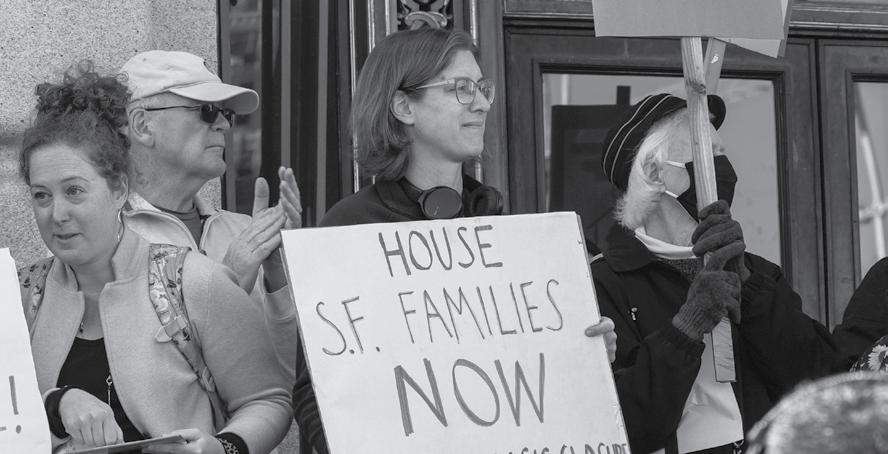
Defensores de la vivienda en lucha por conservar el Refugio Familiar Oasis
El Tecolote
As the only low-barrier shelter for families in the city is set to close on Dec. 15, dozens San Francisco residents, housing advocates and health care workers gathered on Dec. 6 for an emergency rally on the steps of City Hall, protesting the closure of Oasis Family Shelter.
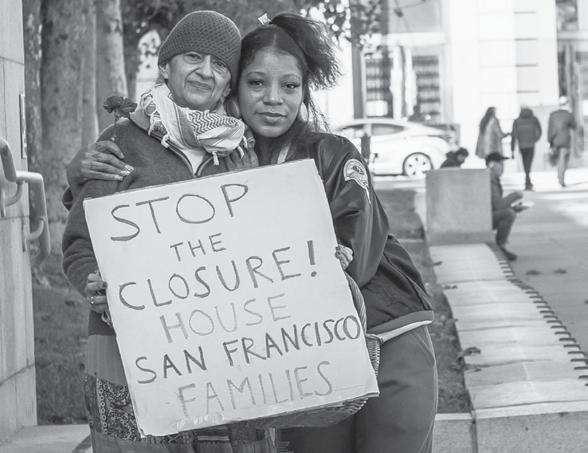

In addition to calling for the shelter to remain open, rally-goers also called on the city to take the immediate and urgent steps to acquire the building, which is located at 900 Franklin street. Rally goers are likewise calling on the owners of the building to sell it to the city or a non profit organization, that would hopefully keep it a low-barrier shelter. Low-barrier meaning that the requirements for accessing housing at said shelter are either limited or minimal. It currently houses 59 families.

“I want to feel hopeful that they will change their mind about the closure, because this is all we have. We don’t have any other alternative after this,” said Cheyanne Tate, who has been a resident of Oasis since February. “This is a last resort for us. We won’t have anywhere else to go after this.”
Dominika Seidman, who is an OBGYN at San Francisco General Hospital and Team Lily, warned of the dangers of Oasis closing.
“We take care of many unhoused pregnant people, who are waiting
for shelter. And they are waiting because the Oasis is always full,” said Seidman. “If we close the Oasis, it will result in more unhoused pregnant people staying on the street. We know that that leads to bad birth outcomes. We know that leads to maternal mortality and death. And the city has a responsibility to take care of its residents, and most importantly, its families.”
The rally was MC’d by Tracey Mixon, who is the Peer Organizer at the Coalition on Homelessness. She said that some families have already left the shelter.
“There has been no offer of permanent housing, the only offers that they have are shelters. And some folks aren’t even getting into shelters,” Mixon said. “So myself personally, I want to continue this fight to ensure that the city does what they have to do to buy this building to keep families safe. I also want to ensure that families get permanent housing. And I’m not going to stop this fight because I’m formerly homeless when my daughter was eight…she’s almost 13 …so I live this and I’ve experienced this and I’m going to keep on fighting for these families.”
The Coalition on Homelessness is encouraging community members to write personal letters to the building’s owners. According to the Coalition, the building is owned by 25 individuals. To learn more about how to write the owners, visit: bit.ly/SavetheOasis
Tecolote
Ante el inminente cierre el 15 de diciembre del único centro de refugio familiar de la ciudad, decenas de residentes, defensores de la vivienda y trabajadores de la salud se reunieron el 6 de diciembre en una concentración de emergencia afuera del Ayuntamiento para protestar por el cierre del Refugio Familiar Oasis.
Además de pedir que el refugio permanezca abierto, los asistentes a la manifestación también pidieron a la ciudad tomar medidas inmediatas y urgentes para adquirir el edificio situado en el número 900 de la calle Franklin. Los manifestantes también piden a los propietarios del edificio su venta a la ciudad o a una organización no lucrativa, lo que permitiría mantenerlo como refugio para familias de bajos recursos. Este refugio actualmente alberga a 59 familias.
“Quiero tener esperanzas de que cambien de opinión sobre el cierre, porque esto es todo lo que tenemos. No tenemos otra alternativa después de esto”, dijo Cheyanne Tate, residente de Oasis desde febrero. “Este es nuestro último recurso. No tendremos otro sitio a dónde ir después de esto”.
Dominika Seidman, ginecóloga obstetra del Hospital General de San Francisco y del Equipo Lily, advirtió de los peligros de su cierre: “Atendemos a muchas embarazadas sin vivienda que están esperando un refu-
gio. Y esperan porque Oasis siempre está lleno. Si cerramos Oasis, más embarazadas sin alojamiento se quedarán en la calle. Sabemos que eso conduce a malos resultados en los partos. Sabemos que provoca mortalidad, y la ciudad tiene la responsabilidad de cuidar de sus residentes y, lo que es más importante, de sus familias”.
El acto fue presentado por Tracey Mixon, organizadora de la Coalición de Personas sin Hogar, quien dijo que algunas familias ya han abandonado el refugio: “No ha habido ninguna oferta de vivienda permanente, las únicas ofertas que tienen son albergues. Y algunas personas ni siquiera están entrando en los refugios”, informó. “Así que personalmente, quiero continuar esta lucha para asegurar que la ciudad haga lo que tiene que hacer para comprar este edificio y mantener a las familias seguras. También quiero asegurarme de que las familias consigan una vivienda permanente. Y no voy a parar esta lucha porque no tuve hogar cuando mi hija tenía ocho años... tiene casi trece [años]... así que he vivido esto y lo he experimentado y voy a seguir luchando por estas familias”.
La Coalición de Personas sin Hogar anima a los miembros de la comunidad a comunicarse por escrito con los propietarios del edificio. Según la coalición, el edificio es propiedad de 25 personas; para saber más sobre cómo ponerse en contacto con ellas, visite esta página web: bit.ly/SavetheOasis
WWW.ELTECOLOTE.ORG Diciembre 15, 2022-Enero 12, 2023 t El Tecolote 3 HOUSING • VIVIENDA
Cynthia Gutiérrez, una defensora de la justicia reproductiva, se moviliza para mantener el Refugio Familiar Oasis. Cynthia Gutierrez, a reproductive justice advocate, rallies to keep the Oasis Family Shelter open. Photos: Jeremy Word
Cheyanne Tate, que desde febrero ha estado en el Oasis Family Shelter, asiste a una manifestación para pedir que este refugio para familias en la ciudad, permanezca abierto. El refugio cerrará el 15 de diciembre. Cheyanne Tate, who has been a resident of Oasis Family Shelter since February, attends a rally calling for Oasis, the only low-barrier shelter for families in the city, to remain open. The shelter is set to close on Dec. 15.
Alexis Terrazas and Jeremy Word
Alexis Terrazas and Jeremy Word
El
HOUSING ADVOCATES RALLY TO KEEP OASIS FAMILY SHELTER OPEN
FRANCISCO
IN SAN
Dominika Seidman, OBGYN del Hospital General de San Francisco y Team Lily, advirtió sobre los riesgos de cerrar el Refugio Familiar Oasis. Dominika Seidman, an OBGYN at San Francisco General Hospital and Team Lily, warned of the dangers of closing the Oasis Family Shelter.
POLITICS • POLÍTICA
PUBLIC OUTRAGE WORKS: KILLER ROBOTS ARE DEAD, AT LEAST TEMPORARILY
2958 24th Street
San Francisco, CA 94110
Tel: (415) 648-1045 www.eltecolote.org
Member SF Neighborhood Newspaper Association

Editor-in-Chief Alexis Terrazas Managing Editor Kari Vídes
Spanish Copy Editor Katie Beas
Web/Social Media Manager Danny Acosta
Audio/Video Editor Monti Rossetti
Layout Design Christian Urrutia
Writers
Carlos Barón; Mara Cavallaro; Jack Davies; Alexis Terrazas; Jeremy Word
Photographers
Mara Cavallaro; Alexis Terrazas; Jeremy Word
Illustrators

Jaycee Felkins; Bruno Ferreira; Korina Moreno
Translators
Katie Beas; Daniel de la Torre; Antonio Valencia Advertising Manager
Chiara Di Martino Chiara@accionlatina.org
*Ads published in El Tecolote do not necessarily reflect the views of the newspaper’s staff, volunteers, or its publisher Acción Latina.
Sometimes, organized public outcry works, particularly in a city with district elections of supervisors, where the public officials making the decision have to be closer to the people who have input.
On Dec. 6, after a bit of parliamentary confusion, the supes voted 8-3 to ban the immediate use of killer robots, and sent the issue back to committee for more discussion.
Only Sups. Rafael Mandelman, Matt Dorsey, and Catherine Stefani voted to keep the previous policy,
which would have allowed the cops to arm robots with bombs to blow up human beings.
Those three supes said they were convinced that the debate was over, and everything that could be said had been said, and the cops should have the right to deploy those weapons if they’re needed.
But over the past week, since the first vote in favor of the killer robots, this has become a national issue, with reporters from news outlets around the country apparently stunned that such a progressive city would allow this.
And a huge public outcry put the supes under close scrutiny, as 44 com-
munity and civil-rights groups demanded that the policy change.
Sup. Aaron Peskin, who had helped negotiate the weapons policy over several public hearings, and who had voted in favor of the robots last week, took the lead in moving to ban lethal force by robots and send the issue back to the Rules Committee.
It took a while. The situation was unusual: The supes had approved the killer robots last week, 8-3, but every ordinance requires a second vote. And in this case, Peskin wanted to send the rest of the police weapons policy, which has a lot of other issues, forward for final approval, with the robot section removed.
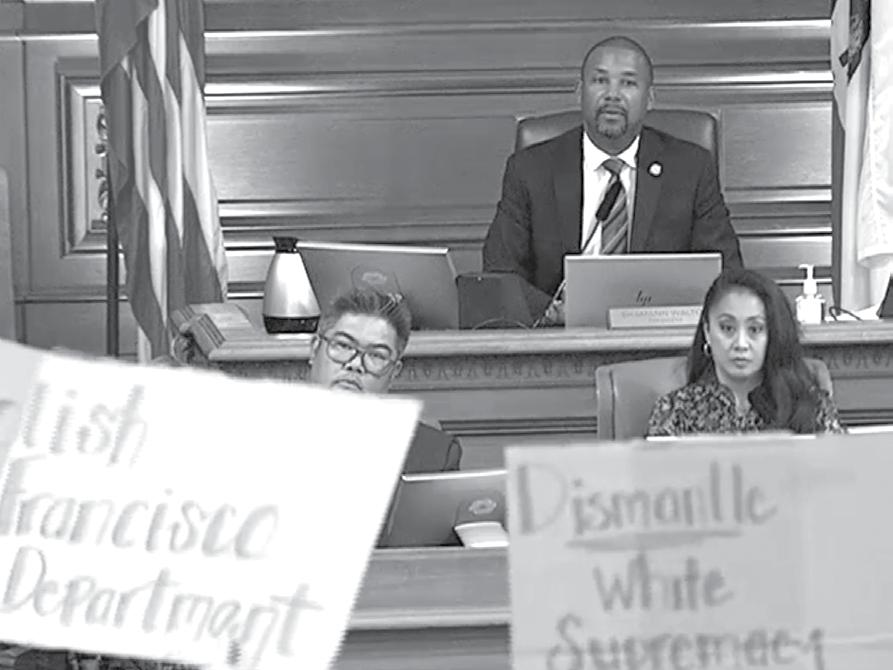
After a lengthy discussion on how that could happen, and a series of votes, the board managed to approve the weapons policy without the robots, specifically ban lethal force by robots, and send that part of the policy back for more discussion.
Which is badly needed. The role of robots in law enforcement is going to become a serious national debate in the next few years, as software developers create AI programs that could allow robots to do threat analysis, and potentially even decide when lethal force is acceptable.
At least for the moment, San Francisco is proceeding with caution.
LA INDIGNACIÓN PÚBLICA FUNCIONA: LOS ROBOT ASESINOS ANIQUILADOS, POR AHORA
Hills
Aveces, la protesta pública funciona, particularmente en una ciudad con elecciones distritales de supervisores, cuyos funcionarios públicos deben estar más cerca de la opinión de las personas.
El 6 de diciembre, tras cierta confusión entre ellos, los superintendentes votaron 8 a 3 para prohibir el uso de los robot asesinos y enviaron el tema de vuelta al comité para una discusión más profunda.
Solo los superintendentes Rafael Mandelman, Matt Dorsey y Catherine Stefani votaron a favor de esta ley, que
habría permitido a la policía armar robots con bombas para eliminar seres humanos.
Esos tres superintendentes dijeron estar convencidos de que el debate había terminado, que todo lo que se podía decir se había dicho, y los policías deberían tener derecho a desplegar esas armas de ser requeridas.
Sin embargo, en la semana pasada, luego de la primera votación a favor de los robot asesinos, esto se ha convertido en un problema nacional y reporteros de todo el país aparentemente se sorprendieron de que una ciudad tan progresista permitiera esto.
Una gran protesta pública puso a los superintendentes bajo escrutinio minucioso, ya que 44 grupos comuni-
tarios y de derechos civiles exigieron cambiar esa ley. El superintendente Aaron Peskin, que había ayudado a negociar la política de armas en varias audiencias públicas y votado a favor de los robots la semana pasada, tomó la iniciativa para prohibir la fuerza letal por parte de estos y derivar este asunto al Comité de Reglas.
Tomó tiempo y la situación era inusual: los superintendentes habían aprobado los robot asesinos la semana pasada 8 a 3, pero cada ordenanza requiere una segunda votación. Y en este caso, Peskin quería enviar para su aprobación final el resto de la ley de armas la cual tiene muchos otros problemas, con la sección de robot suprimida.
Después de una larga discusión sobre cómo podría suceder, y una serie de votaciones, la junta logró aprobar la ley de armas sin robot, prohibiendo específicamente la fuerza letal con la intervención de estos, y devolvió esa parte de la ley para ser discutida a fondo.
Algo muy necesario: el papel de los robot en la aplicación de la ley se convertirá en un debate nacional serio en los próximos años, ya que los creadores de software producen programas de inteligencia artificial que permitirían a éstos analizar amenazas y, potencialmente, decidir cuándo la fuerza letal es aceptable.
Por el momento, San Francisco está procediendo con cautela.
Los manifestantes asisten a la reunión de la Junta de Supervisores de San Francisco el 6 de diciembre, para protestar por la aprobación de la junta para permitir que la policía de San Francisco utilice robot asesinos. Después de la manifestación, la junta cambió de rumbo, votando 8-3, para prohibir temporalmente el uso de dichos robot. Protesters attend the Dec. 6 San Francisco Board of Supervisors meeting, protesting the board’s previous approval of allowing San Francisco police to use killer robots. After much public outcry, the board reversed course, voting 8-3, to temporarily ban the use of said robots. Courtesy: SFGOVTV
Katynka Martinez; Scott Weaver; Ana Montes; Juan Gonzales; David J. de la Torre; Brooke Oliver; Dennis Jaramillo; Patricia Flores
El Tecolote uses 40% postconsumer recycled paper, soybased ink and is printed by Fricke-Parks Press. Accionlatina.org

El Tecolote is published by Acción Latina, a San Francisco non-profit organization. The mission of Acción Latina is to promote cultural arts, community media, and civic engagement as a way of building healthy and empowered Latino communities. Please, send us your feedback: editor@eltecolote.org
Follow us!
Facebook: El TecoloteSF Twitter: @eltecolotesf Instagram: @eltecolotesf
of low-income immigrant communities, which is structural racism, and the lack of appropriate resources for better choices.”
The nation has an issue with making sure dental care is accessible to everyone who needs it. But San Francisco is making significant efforts toward making this less of an issue for the Bay Area. The rest of the country will likely follow, but it’s a matter of taking action to help those who desperately need it.
como por atender a aquellos con planes médicos más caros.
“Para intentar salvar un poco la distancia que separa la salud bucodental de la población infantil, los pediatras revisan ahora los dientes”, explica Musselman. “Remiten a las niñas y los niños a los dentistas. Algo muy importante, sobre todo para los más pequeños, es ponerles barniz de flúor para proteger su esmalte dental. Si se protege el esmalte, se previenen las caries. Las consultas de los pediatras aplican ahora barniz de flúor”.
Larry Vitale, coordinador de
prácticas clínicas de la Universidad Estatal de San Francisco, ha visto a lo largo de sus 38 años de experiencia, el impacto que la dieta puede tener en los dientes de la población infantil latina.
Según él, los inmigrantes que llegan al Área de la Bahía no confían en el agua porque la que tenían en su tierra natal no era apta para beber. En su lugar, las familias optan por alternativas baratas: “Acaban dando a las niñas y los niños lo que les gusta y lo que pueden permitirse ahora, porque es barato. Y eso son las bebidas azucaradas. Esto acaba siendo un problema, no sólo para los dientes, sino para
el peso y todo tipo de cosas. Así que parte de eso es la focalización de las comunidades inmigrantes de bajos ingresos, que es el racismo estructural, y la falta de recursos adecuados para tomar mejores decisiones.
El país tiene problemas para garantizar que la atención dental sea accesible a todos los que la necesitan. Sin embargo, San Francisco está haciendo esfuerzos significativos para que esto no sea un problema en la zona. Es probable que el resto del país se sume posteriormente, es cuestión de actuar para ayudar a quienes lo necesitan desesperadamente.
WWW.ELTECOLOTE.ORG
4 El Tecolote December 15, 2022-January 12, 2023
Distribution Johnny García Photo Archivist Linda Wilson
Acción Latina Executive Director Fátima Ramírez
El Tecolote Founder Juan Gonzales
Acción Latina Board of Directors
Tim Redmond 48
Tim Redmond
48 Hills
TOOTH BUS, from page 2 DIENTES MÁGICOS de página 2
Silent night, shopping night
 Carlos Barón
Carlos Barón
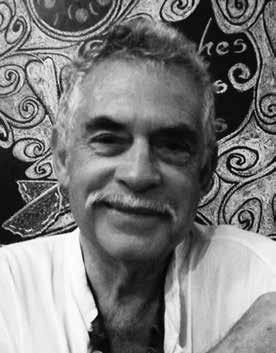 El Tecolote
El Tecolote
Once again, the time has come to shop. I mean, to celebrate “the holidays.”
I grew up in a mainly Catholic country, so the seasonal buying frenzy was associated, loosely, with the birth of baby Jesus. Still, it was secondary to a celebration controlled by a jolly good saint: Santa Claus.
It’s the time of the year for multiple miracles: One, the birthing of a baby by a virgin mother.
Another, the miracle of a snowy Christmas right in the beginning of a hot summer! As is the case in most southern hemisphere countries.
I do not know which miracle is bigger, but I know that the jolly good Santa Claus is a better salesperson.
Perhaps the biggest miracle is to see how economically-challenged people find the time and the money to buy whatever the latest trendy thing the market is pushing down our throats.
For the girls, we might see mothers and fathers fiercely fighting over a talking, singing and peeing doll. For the boys, the fight might be over the latest version of some violent video game. Perhaps preparing them for their future destinies, when they become moms, or brave defenders of our way of life on some foreign lands?
Before someone proposes that I should be excommunicated (tough chance, since I am not a member of any religion or cult), or before I am accused of being a cynical and bitter character from some seasonal musical comedy, (which, by the way, can also be a good present in this time of the year!) let me clarify a couple of things.
Perhaps I should use the word “confess” instead of “clarify.” It might be more seasonally apt.
Thus, I will confess a couple of things. First, I have acted in a couple of those end-of-the year musical shows and I had a great time. I make clear that — in my pagan opinion — I played the best role: The Devil. Or “El Diablote,” in Spanish. As such, I made people laugh, think, or yell obscenities at me, even lifting their
middle fingers in (I hope) fake anger. All in fun, of course. Also in fun, a couple of times, during the curtain call, as I was being booed, I turned around and “mooned” the not-so respectable audiences. It gave me a great devilish pleasure.
Let me also confess that I once was a fervent follower of the cult of “Santa Claus.” As a child, I would not go to church, but I gladly visited some stores downtown (a church of capitalism?) where a sweating man with a fake beard would let me sit on his lap and listen to my gift requests.
In Chile, where I grew up, we called him “El Viejo Pascuero,” or “Viejo Pascual,” which might be the translation for “Old Man Christmas.”
In case anyone questions my former allegiance to the jolly salesman, I kept a letter that I wrote to him, many moons ago, in Spanish. Of course he would speak Spanish! An unquestionable truth!
I have laminated that letter, protecting it from the passing of time.
When I penned that letter I was 6 years old and I was the only one who could write among four of us.
My three sisters were younger, so I became the designated writer.
As I write this column today, I have that letter in front of me, for inspiration.
The letter takes me to tender times, where life, through the eyes of a young child, was less complicated.
Reviewing the list of petitions that I made to “El Viejo Pascuero,” it reads like a time capsule, when our childhood requests were, perhaps, more accessible and or cheaper.
In that mostly grammatically correct and respectful note, I asked for stuff like these: a doll for my youngest sister, who was barely one year old. A ball and a bear for the second sister, a skate (just one?) for the third one.
For my great-grandmother Margarita, who (against her best efforts) saved me from religion with her scary nightly prayers and the bleeding figures on her night table, I asked Santa “Pascuero” to bring her “some grown-up dishes,” whatever that meant.
For our second mother, my nana Yolita…who taught me how to read
and write…an apron. Of course! She was always cleaning the house. For my father…a pair of socks. I guess that I had no idea of what he would have liked instead. For my mother, a necklace.
As for myself, against my eventual anti-military nature, I asked for a rifle and a bugle.
By the way, I clearly remember that ONE time when I was able to form my three sisters on a rather straight line behind me, as I stood in front, holding a stick with which I then led them around the house. It worked…for about 5 minutes. After those 5 minutes, it never happened
again. My sisters resisted my leadership, forming a solid front against me. I had to learn the art of negotiation.
My last confession is that I will be looking for some gifts for my children and grandchildren. I will try to be creative…and frugal.
I really wish you all a wonderful time in these final days of the year
Suggestion: do something creative. It might be an original poem, a drawing, a special dish that you cook, a phone call…or perhaps (dare I dream?) a letter to someone you love. Handwritten! And mail it, via the old “snail mail.”
Noche de paz, noche de compras
El Tecolote
Otra vez, ha llegado el tiempo de gastar. Digo, de celebrar las fiestas de fin de año.
Crecí en un país principalmente católico. Ahí, la locura adquisitiva navideña se asocia al nacimiento del Niño Jesús. Pero otro santo manda en la fiesta: Santa Claus.
Es también la época del año para que ocurran varios milagros. Uno, el que una madre virgen dé a luz. Otro, el milagro de una noche nevada en pleno comienzo del verano, como sucede en los países del Hemisferio Sur. No sé cuál milagro es mayor, pero sí creo que el mejor vendedor es Santa Claus.
Tal vez el milagro más sorprendente es ver cómo muchos con problemas económicos encontramos el tiempo y el dinero para comprar la última novedad que el mercado nos empuja por la garganta.
Para las niñas, habrá madres y padres peleando por una muñeca que habla, canta y hace ‘pipi’.
Para los niños, la lucha puede ser por la última versión de un violento juego de video. ¿Tal vez sea una preparación a futuro, para cuando ellas sean madres y ellos defensores de “nuestro modo de vida” en algún país extranjero?
Antes de que alguien sugiera que debo ser excomulgado (no funcionaría, pues no soy miembro de ningún
culto o religión), o antes de ser acusado de cínico o de semejar algún amargado personaje en una comedia musical de temporada —lo cual podría ser un buen regalo—, deseo clarificar un par de cosas.
Voy a usar la palabra “confesar”, en vez de “clarificar”. Más apta para la temporada. Primero, confieso que he actuado en un par de esas comedias musicales de fin de año… y que la pasé muy bien. En mi pagana opinión, creo que me tocó el mejor papel, el más interesante: el del Diablote.
Como tal, hice reír o pensar al público, o les saqué insultos, y el mostrar los furiosos dedos medios, llamados dedos del corazón. Creo que no estaban realmente furiosos. Bromeaban. También bromeaba yo un par de veces, durante el saludo final, cuando me abucheaban. Me puse de espaldas al “respetable público”, me bajé los pantalones y les mostré mis calzoncillos. Eso me provocó un diabólico placer. Además, confieso que por varios años fui un ferviente seguidor del culto de Santa Claus. Nunca fuí a alguna iglesia ni a otro sitio donde abundaran los santos, pero fui feliz visitando alguna tienda comercial del centro de la ciudad (¿una iglesia del capitalismo?), donde un sudoroso hombre de falsa barba me sentaba en sus rodillas y pretendía escuchar mis pedidos de regalos. En Chile, donde crecí, lo llamábamos ‘El Viejo Pascuero’, o ‘Viejo Pascual’, nombre que parece ser una traducción de ‘Old Man Christmas’.
Si persisten las dudas respecto a mi pasada creencia en ese jovial vendedor, contaré que guardé una carta que le escribí, en español, hace muchas lunas. ¡Por supuesto que ese Viejo habla español! Es algo incuestionable. Laminé esa carta, protegiéndola del paso del tiempo. Cuando la escribí tenía 6 años de edad y era el único de los pequeños que sabía escribir. Mis tres hermanas eran menores que yo. Fui el escritor designado.
Hoy tengo esa carta frente a mí, para inspirarme. Ella me transporta a tiempos más tiernos.
La vida, a través de mis ojos de niño, era menos complicada. Revisando la lista de peticiones que hice al Viejito Pascuero, me parece ver una cápsula de tiempo reflejando una época cuando nuestros pedidos infantiles eran más baratos y accesibles.
Es una nota gramaticalmente correcta y respetuosa, donde pido cosas como estas: una muñeca para mi hermanita menor, de apenas un año de edad; una pelota y un osito para la segunda hermana; una patineta (¿solo una?) para la tercera. Para mi bisabuela Margarita, quien a pesar de su incesante proselitismo no logró enlistarme en su religión (me asustaban sus rezos nocturnos y esas figuras que sangraban en su velador), pedí al ‘Viejo Pascuero’ que le trajera un ‘servicio de grades’. Creo que quise pedir un juego de cucharas, tenedores y cuchillos para adultos.
Para nuestra segunda madre, mi
querida Nana Yolita, que me enseñó a leer y escribir, le pedí un delantal. Claro, pues siempre estaba limpiando cosas. Para mi padre, un par de calcetines. Ahí me faltó imaginación, creo. Para mi madre, un collar. Para mí, a pesar de mi eventual naturaleza antimilitar, pedí un rifle y una corneta.
A propósito, recuerdo claramente la única vez cuando logré formar a mis hermanas detrás mío, en una fila relativamente derecha. Después, usando una ramita de árbol, las guié por una breve marcha alrededor de la casa. Funcionó… por 5 minutos. Después de ese tiempo, esa marcha no se repitió. A pesar de mi flamante rifle y la corneta sonora, mis hermanas resistieron mi liderazgo, formando un sólido frente en mi contra. Tuve que hacerme experto en el arte de la negociación.
Tengo una última confesión: seguramente me verán buscando regalos de última hora para mis familiares. Especialmente para las nuevas generaciones. Trataré de ser creativo y frugal.
A la gente que lea esto: les deseo mucha felicidad en estos últimos días del año. Sugerencias: escriban un poema original, hagan un dibujo, o un plato especial cocinado con amor. O una llamada por teléfono que hayan postergado, Si puedo soñarlo, ¡escriban una carta a mano para alguien especial y mándenla por correo regular! El que hoy se conoce como correo tortuga”, o ‘snail mail’, en inglés.
WWW.ELTECOLOTE.ORG Diciembre 15, 2022-Enero 12, 2023 El Tecolote 5 THE DEVIL’S ADVOCATE • EL ABOGADO DEL DIABLO
Illustration: Bruno Ferreira
Carlos Barón
“Tal vez el milagro más sorprendente es ver cómo muchos con problemas económicos encontramos el tiempo y el dinero para comprar la última novedad que el mercado nos empuja por la garganta.”
Lotería Cards by Korina Moreno. Funded by the CA Department
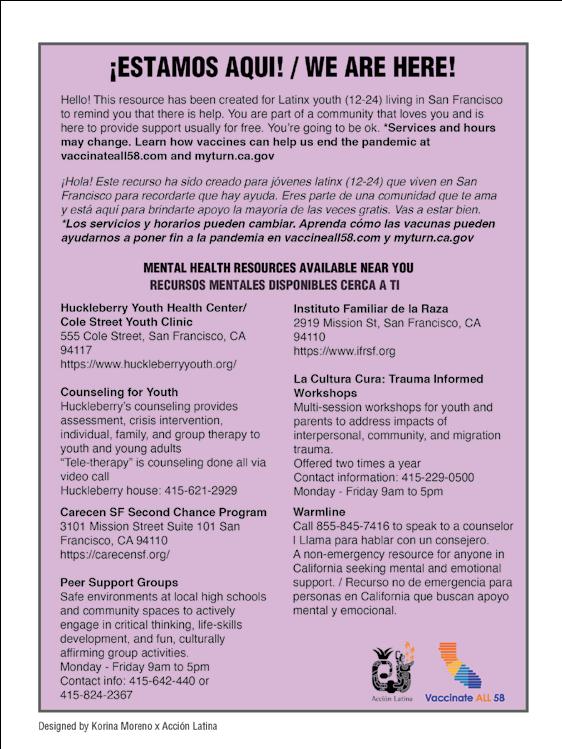

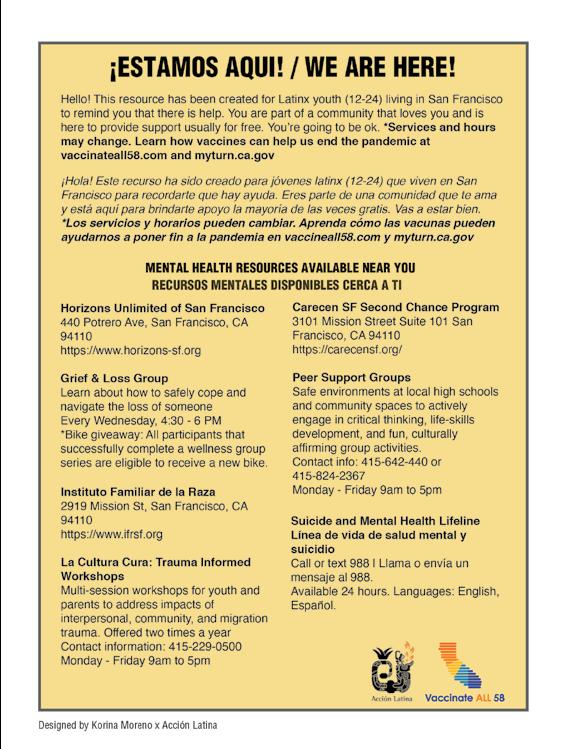

WWW.ELTECOLOTE.ORG 6 El Tecolote December 15, 2022-January 12, 2023 COMMUNITY RESOURCES
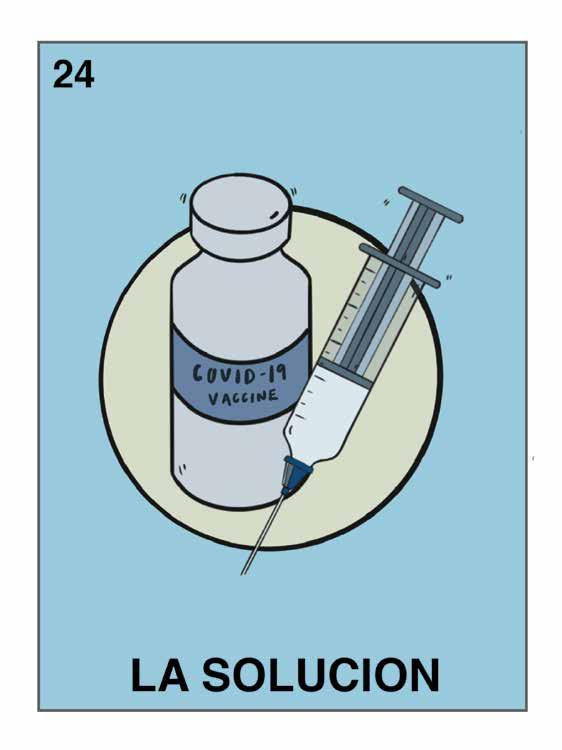

WWW.ELTECOLOTE.ORG Diciembre 15, 2022-Enero 12, 2023 El Tecolote 7 RECURSOS COMUNITARIOS TransbayTube 16th St Mission Ness Civic Center Powell Union Square/ Market Street Yerba Buena/Moscone Yerba 4th/Brannan Chinatown – Rose Pak Montgomery Embarcadero 4th & King CityHall Coit Tower Oracle Park Chase Center Moscone Center SanFrancisco-OaklandBayBridge Ferry Building Salesforce Transit Center Embarcadero Plaza Civic Center Plaza Union Square YerbaBuenaGardens Paci c Broadway Vallejo Green Filbert Greenwich Lombard Chestnut Francisco Bay Beach Je erson Bush Pine Jackson Ellis Eddy Turk Howard Harrison FolsomFremontBealeMainSt Spear 1stSt 5thSt 6thSt 7thSt 2ndSt Sutter Clay Post Geary O’Farrell Union North Point 3rdSt 4thSt 3rd St Mission Columbus Division T e r y A F ancoi s De Carolina Wisconsin Arkansas Connecticut Missouri Texas Mississippi Pennsylvania Brannan Townsend 8thSt 9thSt 10thSt 11thSt 12thSt 13th St 16th St Mission Rock 17th St 18th St 19th St Mariposa Illinois Bryant Leavenworth Hyde Larkin Polk Jones Taylor Mason Powell Grant Kearny Montgomery Sansome Battery Front Washington Golden Gate King Sacramento McAllister Stockton California TheEmbarcadero Ness Market Th e Emb a r c a d e r o Department
Public Health, Neighborhood Partnership
of
Program.
AN ODE TO LIFE AND DEATH: CHILEAN AUTHOR PUBLISHES FIRST POETRY BOOK
Alexis Terrazas
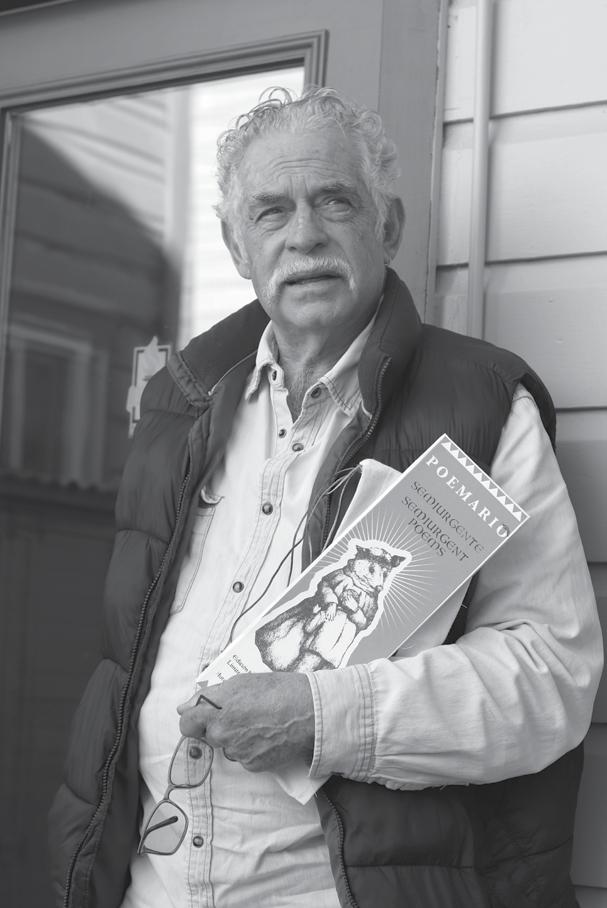 El Tecolote
El Tecolote
The democratically-elected government of Salvador Allende had just fallen. And a 25-yearold Carlos Barón, alongside a group of Chilean theater students, weren’t going to stay silent.
They had agreed to defend their country’s first Socialist government.
But the September 11, 1973 Coup d’état that ousted and killed Allende and installed the torturous reign of Pinochet — one that was supported by the United States — had quickly militarized Chile’s presidential Palacio de La Moneda and its surrounding streets of Santiago. Soldiers were shooting and taking civilians prisoner. And Barón and his classmates found themselves walking past a military barracks, guarded by three soldiers armed with machine guns.
Amid that tension, ugliness and uncertainty, Barón noticed a woman, beautiful and angry, walking towards him and the armed guards.
“One look at his woman and you can tell that she is furious,” Barón remembered. The woman, fist clenched, kept walking until she was directly in front of the soldiers. “Shoot me motherfuckers, kill me if you dare!” yelled the woman at the soldiers, ripping open her shirt and exposing her breasts in defiance.
The soldiers didn’t shoot.
“[The soldiers] were people too, they were working class, they were poor. Maybe that night they would become torturers … but one thing they were not going to do was shoot this woman,” Barón said.
Seeing a moment where they could escape the soldiers, Barón and the students approached the woman, urging her to keep moving. Awaking from her trance, she covered herself, smiled and said, “Venceremos,” We shall win, before walking away.
“And that became a poem,” Barón said. “But it was more than a poem. It was hope.”
That moment, among others, is captured in Barón’s “Semiurgent Poems - Poemario Semiurgente,” a handcrafted bilingual book of poetry and art, which was released just last
month. The work, which is Barón’s first published book, features seven original bilingual poems, each published in English and Spanish. They are a collection of what Barón calls “found poems,” literary tributes to some of the fleeting yet unforgettable moments that Barón, now 75, has written down over the years. They are moments that are unscripted and unplanned. And memorable perhaps for that reason.
The book, in that same spontaneous spirit, was born out of chance while Barón was vacationing with his wife, Diana Azucena, in Veracruz this past summer. It was there that he met silkscreen artist Manuel Tapia, of the art studio “Tapia Ediciones” in Veracruz. Among Tapia’s many talents is crafting books by hand. After some brief introductions and small talk, Barón revealed that he had a collection of poems, none of which had been published. Tapia jumped at the chance to publish them. And so the international literary collaboration was born.
Accompanying the seven bilingual poems are original art illustrations by Bruno Ferreira and Itzel Cruz. Each poem and illustration was meticulously screen printed onto each page, and bound into what is truly a unique work of art.
The illustration that graces the book’s cover is one done by Cruz and was likewise inspired by another of Baron’s poems. That poem, “Confesión de fin de año” (End of Year Confession), walks us through Barón’s assassination — and subsequent guilt — of an Opossums that broke into his house two nights in a row. Caught in his trap, the opossum bared its teeth and growled.
“Out of sheer ignorance and fear, they go hand in hand, I killed this opossum … and I was guilty for about a year,” confessed Barón.
So to process that guilt, Barón wrote an ode to the fallen mammal on the last day of the year, hence the title of the poem. And it was that poem, or confession, that Barón read for the first time in Veracruz. Itzel Cruz was in the crowd that night, who had an opossum as a pet.
“She reacted to what she heard, and she did an amazing image,”
Barón said.
Indeed. There are other images, too. All powerful and beautiful in their own right. But two that stand out — one illustrated by Cruz and the other by the award-winning Mexican cartoonist Ferreira — are the ones paired alongside Barón’s epic poem to Martín Getsemany Sánchez García, one of the forcibly disappeared Ayotzinapa students.
“It fell in my lap the possibility of writing about it,” Barón said. A month after the forcible disappearance of the 43, Barón’s friend and
For that poem, which is based on factual findings of Martin’s life, Barón evoked poetic license for details he couldn’t find.
“As I was writing about him, all of sudden it became this epic poem. I couldn’t just write about him, but about the history of the school, how this became a symbol of disappeared people anywhere … how answers that should be provided are not provided, and how the poor are always
Carlos Barón con su primer libro publicado, Poemario Semiurgente, un libro bilingüe de poesía y arte hecho a mano, que fue presentado el mes pasado. Carlos Barón poses for a portrait holding his first published book, “Semiurgent Poems - Poemario Semiurgente,” a handcrafted bilingual book of poetry and art, which was released just last month.
the number one victim everywhere,” Barón said.
The 24th street community bookstore, Medicine for Nightmares, hosted Barón’s book launch on Dec. 11. The book was on sale, all while people ate, drank Chilean wine, and danced. The book, for which 70 copies were printed, is going for $100, a fair price for a unique and quality item. To purchase a copy of Semiurgent Poems - Poemario Semiurgente, visit here: shorturl.at/EGJRX
Acababa de caer el gobierno elegido democráticamente de Salvador Allende. Y un Carlos Barón de 25 años, junto a un grupo de estudiantes de teatro chilenos, no se iban a quedar callados. Habían acordado defender al primer gobierno socialista de su país.
Pero el golpe de estado del 11 de septiembre de 1973 que expulsó y asesinó a Allende e instaló el tortuoso reinado de Pinochet —uno que contó con el apoyo de los EEUU— militarizó rápidamente el Palacio de La Moneda presidencial y las calles aledañas de Santiago.
Los soldados disparaban y tomaban prisioneros civiles. Y Barón y sus compañeros de clase se encontraron caminando frente a un cuartel militar, custodiado por tres soldados armados con ametralladoras.
En medio de esa tensión, fealdad e incertidumbre, Barón notó que una mujer, hermosa y enojada, caminaba hacia él y los guardias armados.
“Una mirada a esa mujer y te das cuenta de que está furiosa”, recordó Barón. La mujer, con el puño cerrado, siguió caminando hasta quedar directamente frente a los soldados. “¡Dis-
párenme hijos de puta, mátenme si se atreven!” gritó a los soldados, rasgando su camisa y dejando al descubierto sus pechos en desafío.
Los soldados no dispararon. “[Los soldados] también eran personas, eran de clase trabajadora, eran pobres. Tal vez esa noche se convertirían en torturadores… pero una cosa que no iban a hacer era dispararle a esta mujer”, dijo Barón.
Al ver un momento en el que podrían escapar de los soldados, Barón y los estudiantes se acercaron a la mujer, instándole a que avanzara. Al despertar de su trance, se cubrió, sonrió y dijo, “Venceremos”, antes de alejarse.
“Y eso se convirtió en un poema”, dijo Barón. “Pero era más que un poema, era esperanza.
Ese momento, entre otros, está capturado en Semiurgent PoemsPoemario Semiurgente, un libro bilingüe de poesía y arte hecho a mano, que fue presentado el mes pasado. La obra, primer libro publicado de Barón, presenta siete poemas bilingües, cada uno en inglés y español. Son una colección de lo que su autor define como “poemas encontrados”, tributos literarios a algunos de los momentos fugaces pero inolvidables que Barón, ahora de 75 años, ha escrito a lo largo de los años. Son momentos espontáneos y no planeados.
Y memorables tal vez por eso.
El libro, con ese mismo espíritu espontáneo, nació de la casualidad mientras su autor estaba de vacaciones con su esposa, Diana Azucena, en Veracruz, el verano pasado. Fue allí donde conoció al serigrafista Manuel Tapia, del estudio de arte Tapia Ediciones. Entre los muchos talentos de Tapia está la elaboración de libros a mano. Después de algunas breves presentaciones y una pequeña charla, Barón reveló que tenía una colección de poemas inéditos. Tapia aprovechó la oportunidad de publicarlos. Y así nació esta colaboración literaria internacional.

A los siete poemas bilingües le acompañan ilustraciones originales de Bruno Ferreira e Itzel Cruz. Cada poema e ilustración fue impresa en serigrafía meticulosamente en cada página y encuadernados en su conjunto para formar una obra de arte única.
La ilustración que adorna la portada del libro es de Cruz, inspirada en otro poema de Barón, “Confesión de fin de año”, que conduce a través del asesinato, y la posterior culpabilidad, que Barón hizo de una zarigüeya que irrumpió en su casa dos noches seguidas. Atrapada en su trampa, la zarigüeya enseñó los dientes y gruñó.
“Por pura ignorancia y miedo, de la mano, maté a esta zarigüeya… y
me sentí culpable como por un año”, confesó Barón.
Entonces, para procesar esa culpa, Barón escribió una oda al mamífero caído el último día del año, de ahí el título del poema. Y fue ese poema, o confesión, que Barón leyó por primera vez en Veracruz. Itzel Cruz estaba entre la multitud esa noche, quien tenía una zarigüeya como mascota. “Ella
reaccionó a lo que escuchó e hizo una imagen increíble”, dijo Barón.
También hay otras imágenes, todas poderosas y hermosas por sí mismas. Pero dos que se destacan, una ilustrada por Cruz y la otra por el galardonado caricaturista mexicano Ferreira, son los que se combinan
WWW.ELTECOLOTE.ORG
journalist Chelitz Lopez invited him to write about one of the 43. The name Carlos received was Martin’s.
8 El Tecolote December 15, 2022-January 12, 2023 ARTS & CULTURE • ARTE Y CULTURA
Carlos Barón con su primer libro publicado, Poemario Semiurgente, un libro bilingüe de poesía y arte hecho a mano, que fue presentado el mes pasado.
Carlos Barón poses for a portrait holding his first published book, “Semiurgent Poems - Poemario Semiurgente,” a handcrafted bilingual book of poetry and art, which was released just last month.
Photos: Alexis Terrazas
Alexis Terrazas
El Tecolote
ODA A LA VIDA Y A
MUERTE: AUTOR CHILENO PUBLICA SU PRIMER POEMARIO
LA
“And that became a poem, but it was more than a poem. It was hope. ”
Vea POEMARIO, página 9
- Carlos Barón
Today, Las Libres can receive over 100 requests for help daily from the U.S., and in total, they estimate they’ve been able to help thousands of people in the U.S. have abortions. “Before, in Mexico and all of Latin America, the United States was the objective we sought to reach. We all wanted to have our own Roe v. Wade,” the group’s founder, Verónica Cruz, said. But now that Mexico has decriminalized abortion, “the U.S. has to learn from Latin America. And what is still to come needs to be better than Roe. The fight of the next decade, around the world, is for universal access.”
Spike first learned about Las Libres in November, and was immediately inspired by their approach. “The pill is something that can show up at your mailbox that can cut through all of those bureaucracies and draconian laws and get women access,” she told El Tecolote. “Access [for] a woman who can’t get to a clinic, who can’t travel across state lines, who has kids at home [or] a job that they can’t miss.” That same week, she emailed Verónica Cruz a short message—just four lines—with the subject “Hola.” It began, “Somos un grupo de mujeres en San Francisco, California... Queremos apoyarles en su trabajo de distribuir las medicinas para abortos a todas.” The next day, the two women met over Zoom, and by the next week after that, they had planned a fundraising event in San Francisco’s Mission District, where I met Spike for the first time.
She wore a Black Lives Matter shirt and a butterfly-print mask, wasted no time, and spoke her mind, commanding the room with her confidence. But like many others in the ‘post-Roe abortion underground,’ she was worried. When we spoke, we were careful not to mention the name of her fundraising group, or any of its donors. When I offered to delete the recording of our interview following publication, she quickly agreed. It was a matter of safety.
Though the immediate aftermath of Dobbs was the end of medically administered abortions in states like Texas, Alabama, and Oklahoma, a more insidious, far-reaching result has been the U.S. surveillance state expanding into the most private of spaces, and treating them as a battleground—sparking fear about period trackers, text messages, and out-ofstate travel. Often, people who reach out to Las Libres for help use fake Instagram accounts, or the encrypted messaging app Signal.
In Texas, mailing pills within the state to “facilitate a self-induced
abortion…is a felony punishable by up to two years in prison,” the New Yorker reported. In Mississippi, the same act could mean up to five. It’s with good reason that members of Las Libres’ network, and those who fundraise for it, are cautious. But as far as their organizational model goes, it’s fairly foolproof. When you take an abortion pill, it dissolves in your body without a trace. The pills mimic a natural miscarriage, which happens in about 10-20 percent of pregnancies anyway. “There is [currently] no way for anyone to know as long as [you] don’t say that [you] used pills,” Dr. Eleanor Drey, the medical director of San Francisco General’s abortion clinic, confirmed.
In a country where for many abortions are now either illegal or inaccessible, it’s important we learn how to take care of ourselves and each other. That knowledge, and the tools to use it, are exactly what Verónica and Spike are trying to disseminate. “Whether legal or not, women have to have control of their bodies,” Kahn emphasized. And, as Cruz says, it’s international solidarity among women that is saving lives.
On Saturday, dozens gathered at Acción Latina to hear Cruz speak, and donated a total of $2,220 to fund Las Libres’ abortion kits. Others signed up to be acompañantes.
“The people we accompany when we guarantee safe abortions almost all write us messages afterwards. They always say, ‘You’re an angel. You saved my life,’” Cruz told the audience. Drey nodded, and raised her hand. “This is often very young people who feel like their entire lives have been given back to them, and yet we don’t talk about years of life we’ve given to so many people [the way] we talk about the years of life given to someone when you treat them for cancer,” she added, citing George Tiller, the Kansas physician who was assassinated in 2009 for performing abortions. “So I really thank you for your work, because you’re really saving peoples’ lives.”
To read more about Las Libres, see El Tecolote’s Q&A with Verónica Cruz from our December 1st issue. For more information about medication abortions, visit plancpills. org.
To donate to Las Libres, visit laslibres.org.mx/2022/donaciones/
To request abortion pills from Las Libres, email laslibresgto@proton. me. For SMS, Signal, or WhatsApp, reach out to +524731727025.
do las estructuras sociales fallan. Y ha tenido éxito.
En la actualidad, Las Libres pueden recibir más de 100 solicitudes de ayuda de los EE UU al día, y en total, estiman que han podido ayudar a miles de personas en este país a abortar. “Antes, para las mexicanas como para toda América Latina, los EEUU era el objetivo. Todas queríamos tener nuestra propia Roe vs. Wade”, dijo la fundadora del grupo, Verónica Cruz. Pero ahora que México ha despenalizado el aborto, “los EEUU tiene que aprender de América Latina. Y lo que venga después de la Roe tiene que ser mejor. Creo que la lucha de la próxima década del mundo es el acceso universal”.
Spike se enteró por primera vez de Las Libres en noviembre e inmediatamente se sintió inspirada por su abordaje. “La píldora es algo que puede aparecer en su buzón de correo que puede atravesar todas esas burocracias y leyes draconianas y hacer que las mujeres tengan acceso”, le dijo a El Tecolote. “[El] Acceso [para] una mujer que no puede ir a una clínica, que no puede viajar a través de las fronteras estatales, que tiene hijos en casa [o] un trabajo que no puede perder”. Esa misma semana, le envió un correo electrónico a Verónica Cruz con un mensaje corto, de solo cuatro líneas, con el asunto “Hola”. Comenzaba, “Somos un grupo de mujeres en San Francisco, California. Queremos apoyarles en su trabajo de distribuir las medicinas para abortos a todas”. Al día siguiente, las dos mujeres se conocieron por Zoom y, a la semana siguiente, habían planeado un evento de recaudación de fondos en el Distrito Misión de San Francisco, que fue donde conocí a Spike.
Llevaba una camisa de Black Lives Matter y una máscara con estampado de mariposas, no perdió el tiempo y dijo lo que pensaba, dominando la habitación con su
confianza. Pero al igual que muchos otros en el ‘mundo clandestino del aborto posterior a la Roe’, estaba preocupada. Cuando hablamos, tuvimos cuidado de no mencionar el nombre de su grupo de recaudación de fondos ni de ninguno de sus donantes. Cuando le ofrecí eliminar la grabación de nuestra entrevista después de la publicación, aceptó rápidamente. Era una cuestión de seguridad.
Aunque las consecuencias inmediatas de Dobbs fueron el fin de los abortos administrados médicamente en estados como Texas, Alabama y Oklahoma, un resultado más insidioso y de mayor alcance ha sido que el estado de vigilancia de los EEUU se expandió a los espacios más privados y los trató como un campo de batalla: infundiendo temor sobre los rastreadores de períodos, mensajes de texto y viajes fuera del estado. A menudo, las personas que buscan ayuda en Las Libres usan cuentas de Instagram falsas o la aplicación de mensajería encriptada vía Signal.
En Texas, enviar píldoras por correo dentro del estado para “facilitar un aborto autoinducido… es un delito penado con hasta dos años de prisión”, informó El New Yorker. En Mississippi, el mismo acto podría significar hasta cinco años. Es por una buena razón que los miembros de la red de Las Libres, y aquellos que recaudan fondos para ella, son cautelosos. Pero en lo que respecta a su modelo organizativo, es bastante infalible. Cuando tomas una píldora abortiva, se disuelve en tu cuerpo sin dejar rastro. Las píldoras imitan un aborto espontáneo natural, que de todos modos ocurre en aproximadamente el 10-20 por ciento de los embarazos. “[Actualmente] no hay forma de que nadie sepa mientras [usted] no diga que [usó] píldoras”, confirmó la Eleanor Drey, directora médica de la clínica de abortos del Hospital General de San Francisco.
En un país donde para muchas el aborto ahora son ilegal o inaccesible, es importante que aprendamos
a cuidarnos a nosotras mismas y a los demás. Ese conocimiento, y las herramientas para usarlo, es exactamente lo que Verónica y Spike están tratando de difundir. “Ya sea legal o no, las mujeres deben tener el control de sus cuerpos”, enfatizó Kahn. Y, como dice Cruz, es la solidaridad internacional la que está salvando vidas.
El sábado, decenas se reunieron en Acción Latina para escuchar a Cruz y donaron un total de $2,220 para financiar los kits de aborto de Las Libres. Otros se inscribieron para ser acompañantes.
“Las personas que acompañamos para que aborten de manera segura en este territorio, casi todas nos escriben un mensaje después y siempre ponen ‘Eres un ángel. Me salvaste la vida’”, dijo Cruz a los asistentes. Drey asintió y levantó la mano: “A menudo se trata de personas muy jóvenes que sienten que les han devuelto toda su vida y, sin embargo, no hablamos de los años de vida que le hemos dado a tanta gente [la forma en que] hablamos de los años de vida se le da a alguien cuando lo tratas por cáncer”, agregó, citando a George Tiller, el médico de Kansas que fue asesinado en 2009 por realizar abortos. “Así que realmente les agradezco su trabajo, porque realmente están salvando vidas”.
Para leer más sobre el trabajo de Las Libres, consulte la entrevista con Verónica Cruz en nuestra edición del 1 de diciembre. Para obtener más información sobre los abortos con medicamentos, visite plancpills.org.

Para donar a Las Libres, visite laslibres.org.mx/2022/donaciones/
Si desea solicitar pastillas abortivas de Las Libres, envíe un correo electrónico a laslibresgto@ proton.me. Para SMS, Signal o WhatsApp, comuníquese al +524731727025.
junto con el poema épico de Barón a Martín Getsemany Sánchez García, uno de los estudiantes de Ayotzinapa desaparecidos.
“Cayó en mi regazo la posibilidad de escribir al respecto”, dijo Barón. Meses después de la desaparición forzada de los 43, su amiga y periodista Chelitz López, lo invitó a escribir sobre uno de ellos. El nombre que recibió Carlos fue el de Martín.
Para ese poema, que se basa en hallazgos sobre la vida de Martin, Barón evocó la licencia poética para los detalles que no pudo encontrar: “Mientras escribía sobre él, de repente se convirtió en este poema épico. No podía escribir sólo sobre él, sino sobre
la historia de la escuela, cómo se convirtió en un símbolo de las personas desaparecidas en cualquier lugar… cómo las respuestas que deberían darse no se dan, y cómo los pobres son siempre la víctima número uno en todas partes”.
La librería comunitaria en la calle 24, Medicina para Pesadillas, fue sede de la presentación del poemario de Barón, el pasado 11 de diciembre. El libro estuvo a la venta, mientras los asistentes disfrutaron también de comida, bebieron vino chileno y bailaron. El tiraje de esta publicación consta de setenta ejemplares, con un costo de $100. Para adquirir un ejemplar de Semiurgent Poems - Poemario Semiurgente, visite este sitio en internet: shorturl.at/EGJRX.
WWW.ELTECOLOTE.ORG Diciembre 15, 2022-Enero 12, 2023 El Tecolote 9 STORIES CONTINUED • CONTINUACIÓN DE HISTORIAS
LAS LIBRES, from page 1
POEMARIO de página 8
ABORTO SEGURO de página 1
“The people we accompany when we guarantee safe abortions almost all write us messages afterwards. They always say, ‘You’re an angel. You saved my life.”
- Verónica Cruz, Las Libres founder
5 CONSEJOS PARA PASAR UNOS DÍAS FESTIVOS SALUDABLES
1.

Haz del COVID-19 un invitado no deseado.
¡Está bien poner reglas! Bien sea pedir que todos estén al día con sus vacunas contra el COVID-19, o que se hagan la prueba para celebrar de forma más segura.
2.
Mantente saludable para celebrar y disfrutar a plenitud.
Poniéndote la vacuna y el refuerzo actualizado e ayudará a protegerte a ti y a tus seres queridos. De esa manera aprovecharán juntos las festividades.
3.
Haz tus fiestas al aire libre.
Si el clima lo permite, considera hacer tus celebraciones en espacios abiertos.
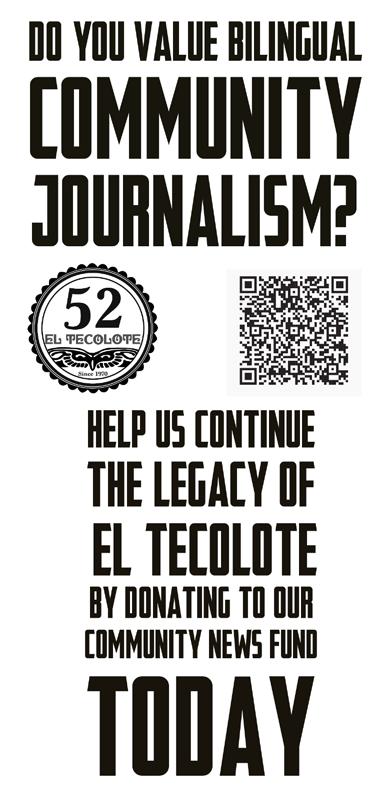
Si te reúnes en espacios cerrados, abre algunas ventanas para que circule el aire.
4.

Hazte la prueba antes de reunirte.
Las pruebas caseras del COVID-19 te brindan una sensación de seguridad antes de cada reunión. Si tu prueba de COVID-19 sale positiva, quédate en casa hasta que los síntomas desaparezcan.
5.
Considera usar mascarilla de acuerdo con los índices locales de transmisión.
WWW.ELTECOLOTE.ORG STORIES CONTINUED • CONTINUACIÓN DE HISTORIAS 10 El Tecolote December 15, 2022-January 12, 2023
Visita MyTurn.ca.gov o llama al 1-833-422-4255 para encontrar una vacuna cerca de ti.
Please send calendar submissions to calendario@eltecolote.org
Favor de enviar información a calendario@eltecolote.org
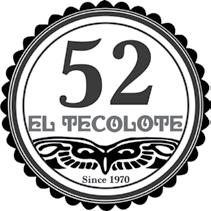
Saturday, December 17 • 7 - 10pm • RESILIENCE; An evening of poetry, experimental films and indigenous Hip Hop happening tonight in our galeria. Featuring the films of Chuli 1312, the poetry of Tatiana LuboviskiAcosta and Wendy Trevino and special guest from New Mexico Bishop Underdog. !Mark Your Sundials For This One! Medicine for Nightmares Bookstore: 3036 24th Street, San Francisco, CA 94110.
Saturday, December 17 • 10am - 2pm • ALLINSF is proud to present the people’s 8th Annual Miracle in the Mission Holiday Giveback. There will be toy giveaways, free food, free haircuts, arts and crafts, raffles, and much more! Mark your calendars and help bring in the holiday spirit for children. Please help and spread the word to the families in need. If you would like to support, volunteer, donate, or sponsor, please email allinsanfrancisco@gmail.com. 2355 Folsom Street, CA 94110.
Tuesday, December 20 • 5:30 - 7:30pm • Free • Queer & Well is a free monthly Center Community Program offering that provides a communal space for LGBTQ+ folks to explore different forms of care rooted in connection to community. Whether it’s caring for ourselves, each other, or communities we are a part of — connection nourishes our bodies, minds, and spirits. Every month, Queer & Well will host various events where folks can participate in and learn about various forms of care such as yoga, art therapy, and more. We are so grateful for the vibrant conversations we have had with our beautiful community since we launched Queer & Well. One of the consistent requests has been a yoga class for beginners - and so we’ve created Yoga FUNdamentals (get it!?) - a class for those who are just starting their yoga journey, and for those seasoned yogis who want to revisit the core of this transformational practice. Led by the incomparable Tony Asaro - the class will cover basic postures, some of the history of the practice and how you can use yoga in your everyday lives. RSVP on Eventbrite.
Saturday, January 14 • 7 - 8pm • $10-$15 Ghostly Labor explores the history of labor in the US–Mexico borderlands through Tap Dance, Mexican Zapateado, Son Jarocho, Afro Caribbean movement, and live music. Co-directed by John Jota Leaños and Vanessa Sanchez, this work brings together polyrhythmic movement and an original score to look at the (ongoing) years of systemic exploitation of labor while highlighting the power and joy of collective resistance. Based on farmworker interviews in California, this work honors the sacred hands that feed us and was filmed on Avila Garcia Farms with support from Ayudando Latinos a Soñar (ALAS), a non-profit advocacy organization for farmworkers in Half Moon Bay, CA. A full-length dance theater production of Ghostly Labor will premiere in 2023. Tickets available soon. Brava Theater: 2781 24th Street, San Francisco, CA 94110. We understand the stress that may surround the holiday’s, therefore, we have compiled a list of resources to help those who may need a little extra support. These resources were pulled from other organizations and groups who are working to provide support.
If you are in crisis, or experiencing thoughts of suicide, please text the Crisis Text Line (text HELLO to 741741) or call the National Suicide Prevention Lifeline at 1-800-273-TALK (8255). Both services are free and available, 24 hours a day, seven days a week
National Alliance on Mental Illness – San Francisco : (415) 905-6264 www.namisf.org
Self-Help Groups for Mentally Ill: (415) 575-1400 (415) 581-1600
Office of Self Help (OASIS) Magnet SF www.magnetsf.org
Magnet’s vision is to promote the physical, mental, and social well-being of gay men, including social support, mental health counseling, and HIV/STD counseling and testing.
Larkin Street Youth Services: www.larkinstreetyouth.org (415) 673-0911
The mission of LSYS is to create a continuum of services that inspires youth, 24 years or younger, to move beyond the street and to establish stable lives.
San Francisco Child Abuse Prevention Center’s: Parental Stress/TALK Line (415) 441-KIDS
Tom Waddell Clinic www.dph.sf.ca.us/chn/healthcenters.htm (415) 554-2950
TWC provides primary medical care and mental health, social, and substance abuse services to homeless, transgenders, low-income, and uninsured individuals in San Francisco.
Edgewood Center for Children and Families Family Resource Center (FRC) (415) 375-7630
Languages: English, Chinese, and Spanish
Urban Services YMCA - Portrero Hill Family Support Center (415) 795-3591
Languages: English, Chinese, and Spanish Dial 211 for essential services
RAMS (clinical services)
Child, Youth & Family Outpatient Clinic - Welcome to RAMS (ramsinc.org)
Services — New Perspectives Center for Counseling (sfnewperspectives.org)
Bay Area Resources List:
CELEBRATING 52 YEARS OF COMMUNITY BILINGUAL JOURNALISM
Back Rent: https://sf.gov/renthelp
Call 211 or check out the 211ca.org and search up rental assistance and this will give you an array of options available.
Big Brother Big Sisters: https://www.bbbs.org/enroll-a-child/ - put in your zip code and it should give you the application from there.
Vouchers/Affordable things to do: https://www.sfhsa.org/free-and-discounted-services-hsa-programrecipients — this include places such as the Exploratorium.
National Resources:
National Suicide Prevention Lifeline
Hours: Available 24 hours. Languages: English, Spanish. (800) 273-8255
NAMI (National Alliance on Mental Illness)
Help Line: 800-950-6264 10 a.m. to 10 p.m.
Text “NAMI” to 741741 for 24/7 for free, confidential crisis counseling.
LGBTQ National Hotline: 1-888-843-4564
National Suicide Prevention Lifeline: 1-800-273-8255 (TALK)
Rape Crisis Hot Line (24 hour): 650.692.7273
Children and Adolescent Hotline: 650.567.5437
Crisis and Suicide Prevention Lifeline 24/7: Dial 9-8-8
Crisis Text Line 24/7: Text RENEW to 741741
Crisis Text Line en español 24/7: Envía un mensaje de texto con la palabra COMUNIDAD al 741741
The Trevor Project Lifeline — Help for LGBTQ+ youth 24/7: (866) 488-7386 or Text START to 678-678
Veterans Crisis Line: (800) 273-8255 (TALK), press “1” for Boys Town National Hotline: (800) 448-3000 or Text VOICE to 20121
Santa Clara: County of Santa Clara Behavioral Health Services 24-hour Suicide and Crisis Line (Santa Clara County) (650) 494-8420 or (408) 279-3312
Uplift (EMQ) Crisis Team (Santa Clara County) (408) 379-9085 or (877) 412-7474 https://bhsd.sccgov.org/
San Francisco: Bay Area center for adolescents (SF) https://www.bayareaadolescent.com/

Marin ACCESS — Mental Health/Therapy Referral Program (Marin based) 1-888-818-1115 BHRSAccessPublic@marincounty.org
Monterey:
Crisis Line (Natividad Hospital): 831-755-4111
Access Line: 1-888-258-6029 | TYY/TDD: 831-796-1788 - This Line Is For Individuals Who Are Deaf, Blind, Hard Of Hearing Or Speech Impaired And Would Like To Use Our Text Telephones (TTY/TTD).
Monterey County Rape Crisis: (24/7) Call 831-424-4357 or 375-4357
Suicide Prevention Hotline 877-663-5433
Crisis Text support 24/7: Text HOME to 741-741
National Domestic Violence Hotline: 1 (800) 779-SAFE (7233)
Local Domestic Violence Crisis Line (bilingual) 831-372-6300
Rapid Response: 877-305-8989
Monterey County: 831-687-4379
WWW.ELTECOLOTE.ORG TECO CALENDAR • TECO CALENDARIO Diciembre 15, 2022-Enero 12, 2023 El Tecolote 11



WWW.ELTECOLOTE.ORG 12 El Tecolote December 15, 2022-January 12, 2023
ILLUSTRATION:
Support El Tecolote’s Community News Fund before Dec. 31st & your impact will be doubled! COMMUNITY RESOURCES • RECURSOS COMUNITARIOS
EL TECOLOTE STAFF
JAYCEE FELKINS
Lotería Cards by Korina Moreno. Funded by the CA Department of Public Health, Neighborhood Partnership Program.












 Carlos Barón
Carlos Barón
 El Tecolote
El Tecolote






 El Tecolote
El Tecolote









